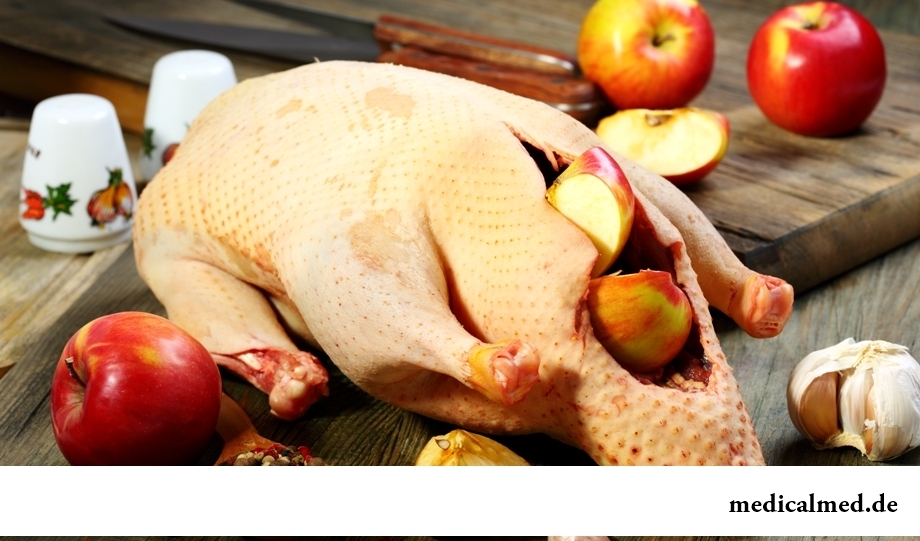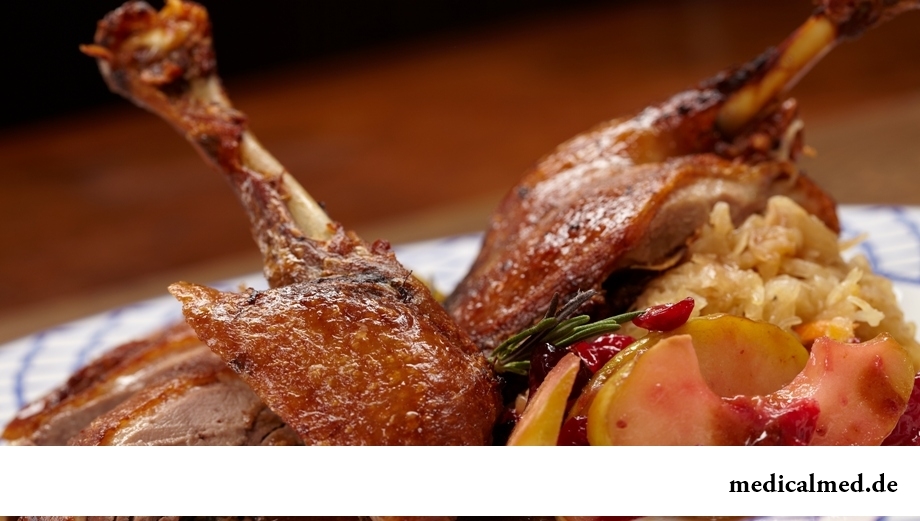





Duck
In cookery the duck plays not the last role. Such dishes as the baked duck with apples, paste of foie gras or a Peking Duck are known to all. And it is still not all list of cult dishes from duck's flesh.

Description
Duck – a bird from family Duck. Depending on a look, she is the small and average sizes. In total in the world there are more than 100 species of ducks from which it is possible to distinguish dives, river, mallards, savka, musky, ducks steamships, etc. The cultivated duck – one of the most widespread birds around the world. They are divided into three main breeds: meat breeds (Beijing, gray Ukrainian, black belogrudy), egg (Indian runners) and myasoyaichny breeds (mirror, khaki-kempbell). On average, the domestic duck weighs 2-4 kg.
Meat breeds grow up for receiving meat. And, these breeds have the increased precocity: at good leaving in two months these ducks gain 2-2,5 kg. Egg ducks are grown up for the sake of receiving eggs and they rush not worse than hens. Myasoyaichny breeds grow up both for receiving duck meat, and for receiving eggs. In two months myasoyaichny breeds grow fat to one and a half kg.
History
The ancestor of modern domestic ducks can be considered a kryakovy wild duck. In different places its domestication happened during the different periods. For example, in the first century B.C. Kolummela, the Roman agricultural scientist, advised to take eggs of wild ducks and to enclose under chicken brood hen that testifies to the beginning of process of domestication. The same scientist in the works wrote that in Rome the special yards for keeping of ducks were organized.
Much earlier taming of ancient ducks happened in China. Exactly there the incubation of duck eggs was for the first time applied - they were put in baskets with the warmed-up chaff and put at each other in the heated rooms. And Indians cultivated a warty duck who was brought afterwards to Europe. Since those times the set of breeds of domestic ducks was removed.
Today in private enterprises the most widespread types are gray Ukrainian and kryakovy ducks.
Duck in cookery
Duck meat belongs to dark types of meat, and the high caloric content of a duck does not allow to rank it as dietary products, unlike white grades of meat. Nevertheless, the advantage of a duck is undoubted and tastes at it just excellent.
Duck's flesh is smoked, salted, cooked, extinguished, fried, baked entirely or in parts. Very widespread festive dish is the duck baked with apples in the furnace or an oven. Before roasting the carcass is stuffed, and not only apples, but also other stuffing: mushrooms, sourcrout, rice, pearl barley or buckwheat, oranges, potatoes, raisin, etc. From duck's flesh it is possible to make excellent roast in pots, various meat salads, pilaf, vegetable stew, sausages, jellies and jellies.
Apply in food not only duck meat, but duck fat and a liver from which cook tasty pastes. The melted duck fat perfectly is suitable for frying. From duck forcemeat it is possible to make excellent cutlets, quenelles or meatballs. And on the basis of duck broth excellent borsches and soups turn out.
Structure and caloric content of a duck
In 100 g of a duck 73,77 g of water, 18,28 g of proteins, 5,95 g of fats, 1,06 g of ashes, 0,94 g of carbohydrates contain; vitamins: Retinolum (A), thiamin (B1), Riboflavinum (B2), Niacinum (RR), pantothenic acid (B5), pyridoxine (B6), folic acid (B9), ascorbic acid (C), cyanocobalamine (B12), calciferol (D), alpha tocopherol (E), sincaline (B4), phylloquinone (K); microelements: selenium, zinc, copper, manganese, iron; macrocells: phosphorus, sodium, magnesium, calcium, potassium.
Caloric content the duck has high, about 350-400 kcal on 100 g of a product.
Advantage of a duck
The main advantage of a duck consists in the high content of vitamins of group B, phosphorus, zinc and selenium.
In spite of the fact that duck meat contains a lot of cholesterol, at it there are also Omega-3 and Omega-6 polyunsaturated fatty acids. Therefore doctors recommend to use duck meat for normal work of cardiovascular system.
The betaine and sincaline which are contained in duck's flesh take active part in a lipometabolism and are necessary for formation of cellular covers. And the amount of Retinolum in duck's flesh is higher, than in other types of meat therefore the advantage of a duck with poor eyesight is obvious to people.

Contraindications
Duck's flesh contains a large amount of cholesterol therefore it does not approach as a dietary food stuff and is not recommended to people with a diabetes mellitus and obesity.
In addition, duck's flesh contains refractory fats which not really well are digested digestive tract. Therefore people should not use a duck with diseases of a stomach, liver and pancreas.
The weight of a human brain makes about 2% of all body weight, however it consumes about 20% of the oxygen coming to blood. This fact does a human brain extremely susceptible to the damages caused by shortage of oxygen.

It is impossible to imagine human life in which there would be no plants. Practically in each apartment and any of productions...
Section: Articles about health
More than a half of the married couples which faced prostatitis – leave. The new broadcast "Female View of Prostatitis" will help to learn – whether you have or your relatives problems....
Section: Articles about health
Bulimia and anorexia, are heavy deviations of a feeding behavior, become a cause of death of patients much more often than all other nervous breakdowns combined. In 60% of cases two illnesses accompany each other: patients feel horror before danger of set of excess weight and try to refuse as often as possible food, but periodically suffer from attacks of sudden hunger and an uncontrollable overeating. Each patient with anorexia and bulimia needs the help qualified пс...
Section: Articles about health
Each of us faces from time to time that other people need the immediate help. We react to it on-raznomu:...
Section: Articles about health
Aspirin (acetylsalicylic acid) – one of those drugs which are known literally to all. It is available in each home first-aid kit, and many accept it at the first signs of an indisposition, often without having a fair idea of properties and a therapeutic eff...
Section: Articles about health
No, probably, the person who would not have cold. Cold, cough, a headache – these symptoms are known to everyone. The peak of catarrhal diseases is the share of fall. SARS already came to schools and kindergartens, flu slowly makes the way to the cities, in a word, winter close!...
Section: Articles about health
When overcomes feeling of hunger, and an opportunity to have dinner fully is absent, having a snack − small on volume comes to the rescue...
Section: Articles about health
Radiological methods of a research are applied in medicine more than hundred years, and thanks to them millions of lives were saved. In many cases without X-ray it is impossible to make exact idea of a condition of bodies and fabrics, it is correct to make the diagnosis. Those...
Section: Articles about health
The popular expression "run from a heart attack" became the motto of the people supporting active lifestyle. Moreover, run became a peculiar fashionable tendency: sales of racetracks and the accompanying goods for run are at permanently high level. Whether really it is possible for one and all people and it is necessary to run to receive the portion of health, a charge of cheerfulness and good mood?...
Section: Articles about health
Partial and the more so full loss of hearing significantly reduces quality of life. Difficulties with communication lead to loneliness and замкн...
Section: Articles about health
The majority of gynecologic diseases prove three main signs, each of which speaks about need of a visit to the gynecologist. Certainly, it is possible to establish the exact diagnosis only after inspection, but on the basis of some signs it is possible пр...
Section: Articles about health
About influence of fasting days on an organism it is told much – both about advantages, and about shortcomings. It is considered that fasting day in the form of a short-term monodiet is useful, promoting effective removal of slags from an organism whereas irregular, excessively long, spontaneous fasting days lead only to deterioration in health. How to derive benefit from the sparing diet and not to do much harm to itself? Let's consider the main advantages and shortcomings of fasting days and their influence on an org...
Section: Articles about health
Childbirth is the most important event in life of each woman. We are women we give birth to the new little man on this light. Now...
Section: Articles about health
The phenomenon of the panic attack is known long ago, but the reasons of its emergence still are up to the end not found out. It is established that more than 30% of people at least once in life become the victims of very unpleasant phenomenon: without everyones on that the reasons they have a feeling of horror, with...
Section: Articles about health
Eyes – one of the most vulnerable areas on a face therefore age changes concern them first of all. Whether it is possible to keep look youth for many years and what procedures are offered for achievement of this purpose by cosmetologists? And maybe, the only option of rejuvenation is surgery – a blepharoplasty? Let's try to understand this question....
Section: Articles about health
Olive oil – the product capable to make a powerful contribution to health of the person if it includes it in the diet. Rich vitamin...
Section: Articles about health
People know that thermal sources have salutary force long ago. Treatment by natural waters is one of the most ancient methods of disposal of the most different diseases. Bathtubs, souls, wrappings and inhalations, in combination with reception of water vnut...
Section: Articles about health
Cold, puffiness of a nose, itch, the watering eyes - characteristic symptoms of the allergic rhinitis resulting from hit of allergens (pollen, house dust, hair of animals, etc.) on a mucous membrane of a nose. Unpleasant feelings often give trouble, serving as the reason of a headache, an acrimony, sleep disorders, and in certain cases and the states close to a depression. How to get rid of undesirable satellites of a disease if near at hand there are no antiallergic...
Section: Articles about health
Proofs of efficiency of Mildronate at treatment of coronary heart disease with stenocardia can be found in many publications to...
Section: Articles about health
The advantage of swimming for the person is so high that this sport is not only the most popular, but also is widely applied in medicine and rehabilitation processes. If you look for for yourself the occupation allowing pleasantly and to spend time, then swimming with advantage...
Section: Slideshow
Separate food - the system of meal based on digestion physiology which is carried to improvement methods. According to nutritionists, the separate use of the carbohydrate and proteinaceous products demanding different conditions of assimilation helps to get rid of diseases of digestive tract and serves as prophylactic from a diabetes mellitus, arthritis, food allergies, cholelithiasis and many other frustration. The essence of salutary effect of a method consists in most Kacha...
Section: Articles about health
The mankind knows that some toxins at intake in the minimum quantities have therapeutic effect...
Section: Articles about health
EKO, or extracorporal fertilization - a method of treatment of infertility which became the reason of a set of broken-down copies in due time accused the people working on its creation neither more nor less of rivalry good luck. Already very few people deny the rights...
Section: Articles about health
Tick-borne encephalitis – one of the most dangerous viral diseases which causative agents transfer and is given to people by ixodic mites. These are the small blood-sicking insects living in the considerable territory of our country. The person bitten by a tick can catch also erlikhiozy, bartonnelezy, babeziozy, mycoplasmosis and Lyme's disease. As well as encephalitis, these illnesses affect the central nervous system, and as specific antiviral therapy does not exist, the forecast very to a neuta...
Section: Articles about health
Deciding to get rid of an addiction, not all imagine what effects it is necessary to face. Process of refusal from ку...
Section: Articles about health
For most of the working people the problem of having a snack is particularly acute enough. Sooner or later there is a question: what can be eaten quickly between a breakfast and a lunch or a lunch and leaving from service so that to receive necessary power feed, but not an overload...
Section: Articles about health
There is a lot of fans of beer in our country. Statistically, on each average Russian (including women and children) in a year about 60 liters of this drink are consumed. It is not a lot of, as in the Czech Republic or Germany, but figure all the same impressive. There is nothing to rejoice here: despite assurances of producers that beer is absolutely harmless, effects of its active consumption cannot be considered positive in any way. Here only part of that negative impact, which popular нап...
Section: Articles about health
